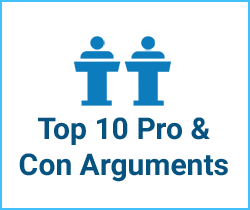
According to The Sentencing Project, about 4.6 million Americans were disenfranchised (not allowed to vote) because of a felony conviction in 2022, down from about 5.2 million in 2020.
Each state determines voting policy for people convicted of felonies within its borders. The policies range from being allowed to vote from prison to permanently losing voting rights.
Estimates of Disenfranchised People with Felony Convictions, 2020*
*The Sentencing Project noted that these estimates are not head counts.
| State | Total Disenfranchised | Voting Age Population | % Disenfranchised |
|---|---|---|---|
| Alabama | 328,198 | 3,671,110 | 8.94% |
| Alaska | 5,541 | 530,385 | 1.04% |
| Arizona | 233,816 | 4,812,764 | 4.86% |
| Arkansas | 87,187 | 2,195,870 | 3.97% |
| California | 243,181 | 25,232,634 | 0.96% |
| Colorado | 22,607 | 3,979,325 | 0.57% |
| Connecticut | 20,124 | 2,600,979 | 0.77% |
| Delaware | 11,524 | 704,108 | 1.64% |
| Florida | 1,132,493 | 14,724,113 | 7.69% |
| Georgia | 275,089 | 7,254,693 | 3.79% |
| Hawaii | 4,899 | 1,016,556 | 0.48% |
| Idaho | 32,500 | 1,192,742 | 2.72% |
| Illinois | 39,005 | 9,055,187 | 0.43% |
| Indiana | 30,659 | 4,876,218 | 0.63% |
| Iowa | 34,227 | 2,312,666 | 1.48% |
| Kansas | 21,256 | 2,077,566 | 1.02% |
| Kentucky | 197,672 | 3,338,198 | 5.92% |
| Louisiana | 76,924 | 3,452,767 | 2.23% |
| Maine | 0 | 1,059,542 | 0% |
| Maryland | 18,778 | 4,262,388 | 0.44% |
| Massachusetts | 8,956 | 4,964,686 | 0.18% |
| Michigan | 38,819 | 7,472,668 | 0.52% |
| Minnesota | 64,700 | 4,037,295 | 1.6% |
| Mississippi | 235,152 | 2,228,659 | 10.55% |
| Missouri | 95,485 | 4,585,994 | 2.08% |
| Montana | 4,221 | 804,263 | 0.52% |
| Nebraska | 22,396 | 1,358,786 | 1.65% |
| Nevada | 14,397 | 1,973,652 | 0.73% |
| New Hampshire | 2,905 | 1,048,201 | 0.28% |
| New Jersey | 19,896 | 6,117,615 | 0.33% |
| New Mexico | 18,451 | 1,485,490 | 1.24% |
| New York | 44,343 | 13,686,685 | 0.32% |
| North Carolina | 83,837 | 7,413,181 | 1.13% |
| North Dakota | 1,821 | 562,632 | 0.32% |
| Ohio | 50,402 | 8,797,915 | 0.57% |
| Oklahoma | 56,995 | 2,819,168 | 2.02% |
| Oregon | 15,871 | 3,002,261 | 0.53% |
| Pennsylvania | 48,823 | 9,748,290 | 0.5% |
| Rhode Island | 2,588 | 789,062 | 0.33% |
| South Carolina | 44,584 | 3,731,348 | 1.19% |
| South Dakota | 13,339 | 635,405 | 2.1% |
| Tennessee | 451,227 | 4,964,909 | 9.09% |
| Texas | 500,474 | 17,859,496 | 2.8% |
| Utah | 7,987 | 1,982,911 | 0.4% |
| Vermont | 0 | 494,674 | 0% |
| Virginia | 366,065 | 6,096,244 | 6% |
| Washington | 45,090 | 5,173,974 | 0.87% |
| West Virginia | 17,274 | 1,442,035 | 1.2% |
| Wisconsin | 69,344 | 4,347,413 | 1.6% |
| Wyoming | 11,403 | 432,284 | 2.64% |
| Total | 5,177,780 | 228,407,007 | 2.27% |
Estimates of Disenfranchised People with Felony Convictions, 2022*
*The Sentencing Project noted that these estimates are not head counts.
| State | Total Disenfranchised | Voting Age Population | % Disenfranchised |
|---|---|---|---|
| Alabama | 318,681 | 3,709,180 | 8.59% |
| Alaska | 6,552 | 532,553 | 1.23% |
| Arizona | 256,636 | 5,049,926 | 5.08% |
| Arkansas | 81,658 | 2,219,479 | 3.68% |
| California | 97,328 | 25,774,911 | 0.38% |
| Colorado | 17,455 | 4,153,976 | 0.42% |
| Connecticut | 6,892 | 2,615,815 | 0.26% |
| Delaware | 7,721 | 723,159 | 1.07% |
| Florida | 1,150,944 | 15,296,734 | 7.52% |
| Georgia | 234,410 | 7,482,329 | 3.13% |
| Hawaii | 3,007 | 1,020,517 | 0.29% |
| Idaho | 27,485 | 1,255,411 | 2.19% |
| Illinois | 31,431 | 9,064,396 | 0.35% |
| Indiana | 25,801 | 4,933,505 | 0.52% |
| Iowa | 30,130 | 2,331,653 | 1.29% |
| Kansas | 19,026 | 2,097,052 | 0.91% |
| Kentucky | 152,727 | 3,362,354 | 4.54% |
| Louisiana | 52,073 | 3,467,869 | 1.50% |
| Maine | 0 | 1,070,612 | 0% |
| Maryland | 16,587 | 4,313,168 | 0.38% |
| Massachusetts | 7,769 | 5,030,986 | 0.15% |
| Michigan | 35,281 | 7,528,995 | 0.47% |
| Minnesota | 55,192 | 4,113,452 | 1.34% |
| Mississippi | 239,209 | 2,238,133 | 10.69% |
| Missouri | 82,782 | 4,630,115 | 1.79% |
| Montana | 4,223 | 823,797 | 0.51% |
| Nebraska | 17,960 | 1,373,561 | 1.31% |
| Nevada | 12,188 | 2,071,272 | 0.59% |
| New Hampshire | 2,524 | 1,065,299 | 0.24% |
| New Jersey | 13,999 | 6,156,380 | 0.23% |
| New Mexico | 17,572 | 1,511,406 | 1.16% |
| New York | 36,553 | 13,764,741 | 0.27% |
| North Carolina | 29,461 | 7,636,496 | 0.39% |
| North Dakota | 1,552 | 564,942 | 0.27% |
| Ohio | 47,010 | 8,855,290 | 0.53% |
| Oklahoma | 41,212 | 2,855,801 | 1.44% |
| Oregon | 13,302 | 3,108,030 | 0.43% |
| Pennsylvania | 42,976 | 9,778,957 | 0.44% |
| Rhode Island | 1,606 | 795,022 | 0.20% |
| South Carolina | 39,882 | 3,849,680 | 1.04% |
| South Dakota | 13,463 | 644,867 | 2.09% |
| Tennessee | 471,592 | 5,082,240 | 9.28% |
| Texas | 455,160 | 18,578,831 | 2.45% |
| Utah | 6,238 | 2,082,893 | 0.30% |
| Vermont | 0 | 497,391 | 0% |
| Virginia | 312,540 | 6,198,540 | 5.04% |
| Washington | 17,001 | 5,344,645 | 0.32% |
| West Virginia | 14,215 | 1,428,525 | 1.00% |
| Wisconsin | 65,394 | 4,392,490 | 1.49% |
| Wyoming | 10,306 | 435,357 | 2.37% |
| Total | 4,644,708 | 232,912,733 | 1.99% |
For more demographic information, including the sentence status and races of disenfranchised people, please visit The Sentencing Project links below.
Christopher Uggen, Ryan Larson, Sarah Shannon, and Arleth Pulido-Nava, “Locked Out 2020: Estimates of People Denied Voting Rights Due to a Felony Conviction,” sentencingproject.org, Oct. 30, 2020
Christopher Uggen, Ryan Larson, Sarah Shannon and Robert Stewart, “Locked Out 2022: Estimates of People Denied Voting Rights, “sentencingproject.org, Oct. 25, 2022


